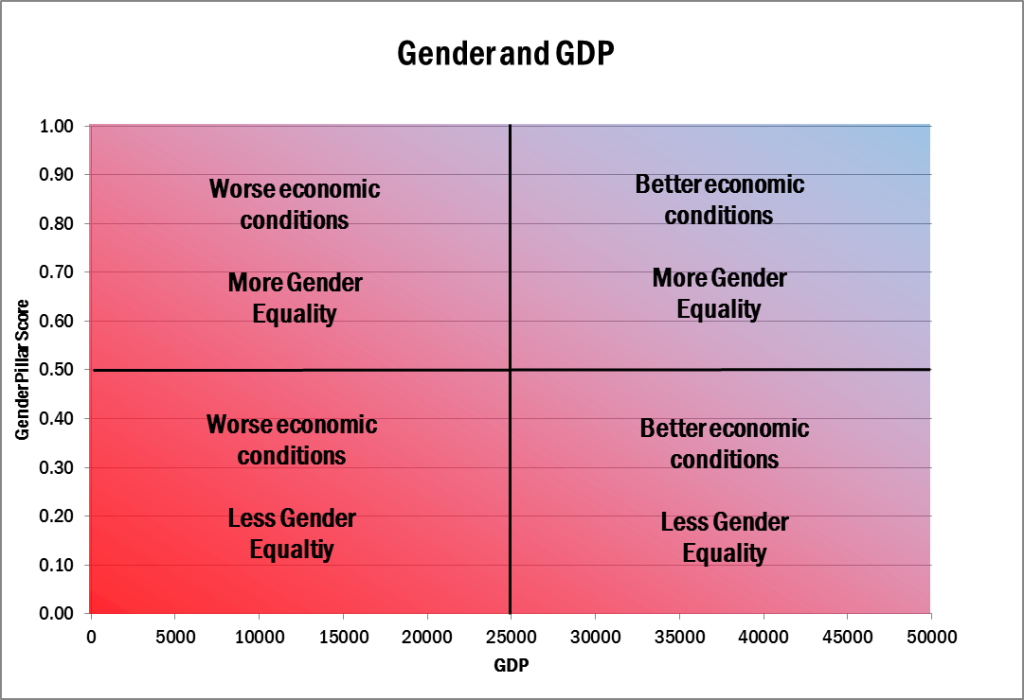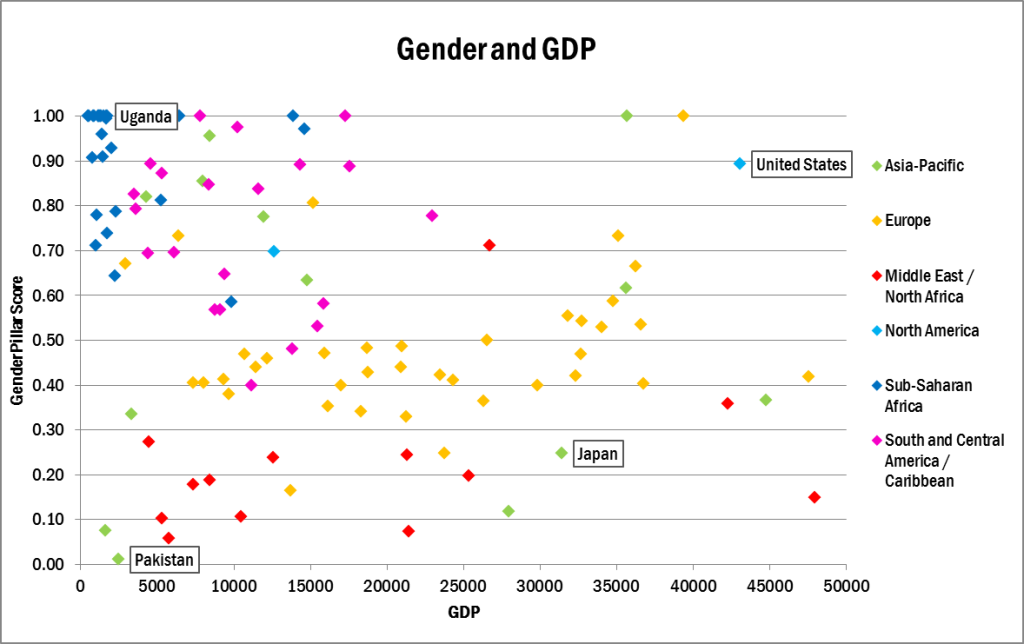Female entrepreneurship is influenced by a complex interaction between markets, institutions and attitudes which has direct effects on entrepreneurial behavior and economic outcomes. In the 2014 Index, we included a pillar to gain insights into the potential gendered effects on women’s entrepreneurship at the country level. The Gender pillar includes two dimensions: the percentage of female start-ups combined with a measure for equal economic participation and opportunity. A useful way to view the results of the gender pillar is through a 2 x 2 matrix which compares the gender pillar scores with a country’s level of GDP.
Figure 1 below has four boxes representing the midpoint of the gender index and $25,000 in GDP about half of global income levels. The first box represents poor economic conditions and low levels of economic participation and opportunity for women. It is where income is low and women’s economic opportunities are restricted. The second box represents a condition that is still economically low but women’s economic participation and opportunities are improved. The lower right hand box represents countries where economic conditions are good but economic participation and opportunities for women are poor. The upper right box represents both good economic conditions and high levels of economic participation and opportunities for women. One would expect countries might go from quadrant one to quadrant four over time.
However as the results of Figure 2 this is not necessarily the case. Economic development alone does not reduce or eliminate gendered inequalities. Market and institutional failures as well as restrictive attitudes must be addressed as they come at an economic cost. Countries able to fully unleash the potential of women as entrepreneurs will be in a better position for sustained economic growth.
Figure 2 below shows our four quadrants for each of the 120 countries in the 2014 GEI index. What is rather surprising is that there is almost no discernable pattern across the countries. In other words, the correlation between gender equality and economic development does not exist. Moreover, the gender pillar does not correlate with the other 14 pillars of GEI nor does it correlate with income. We find countries in all four quadrants.
However when we look at the world from the perspective of different sub regions some patterns do appear. First, and perhaps the most interesting sub-Saharan African countries seem to almost all cluster in the poor economic and greater gender equality. Even the poorest countries appear to offer higher levels of gender equality. Middle East and North African countries seem to cluster mostly in the poor cultural conditions and they straddle both the low income and high income conditions. Europe occupies a place in between these two extremes with most countries around a 0.50 gender score and a middle income level. North America occupies the northeast quadrant with good gender equality and high levels of income. Latin America is closer to better cultural conditions and worst economic conditions.
Four examples stand out. Uganda represents a country with a perfect gender score of 1.0. However, it is a factor driven economy with a per capita GDP of $1,165 or about $3 a day per person. It scores very poorly on almost all of the other pillars including 0.04 on the quality of human resources and 0.07 on high growth firms in the country. Pakistan represents the quadrant with low gender equality and poor economic conditions. It has a more balanced set of GEI indicators with Gender being the worst pillar at 0.01. The country has a GDP of $2,491 per capita and is also a factor driven economy.
The lower right hand box is populated by rich countries characterized by low levels of gender equality. Our example here is Japan, one of the richest countries in the world with a $32,425 per capita GDP and a population of almost 130 million people. Its gender score is 0.25. Japan also has an unbalanced GEI profile with very strong showings in high growth companies, process and product innovation. However, its entrepreneurial strengths are sapped by a lack of start-up skills and opportunity presentation. This does not mean that Japan does not have strong cultural basis for economic development only that it is not shared by all. The United States is our example of a country with high income and good gender equality along with Australia and Singapore. The United States not only ranks first in the GEI index but it scores very high in gender equality with a score of 0.89.
Gender is a complicated subject and difficult to capture through the addition of a gender pillar. Therefore, in 2015 we have dropped the gender pillar from the GEI in favor of exploring it independent from the rest of the index.
In 2013, the Global Entrepreneurship and Development Institute (GEDI) launched the Gender-GEDI which is first ever index for female entrepreneurship. The Gender-GEDI project spearheaded by Ruta Aidis, and sponsored by Dell Computers, ranks and scores countries according to their potential for fostering ‘high impact’ female entrepreneurs (http://www.dell.com/learn/us/en/uscorp1/corporate~secure~en/documents~gender_gedi_executive_report-2014.pdf). We will continue to pursue this avenue to better understand female entrepreneurship.


